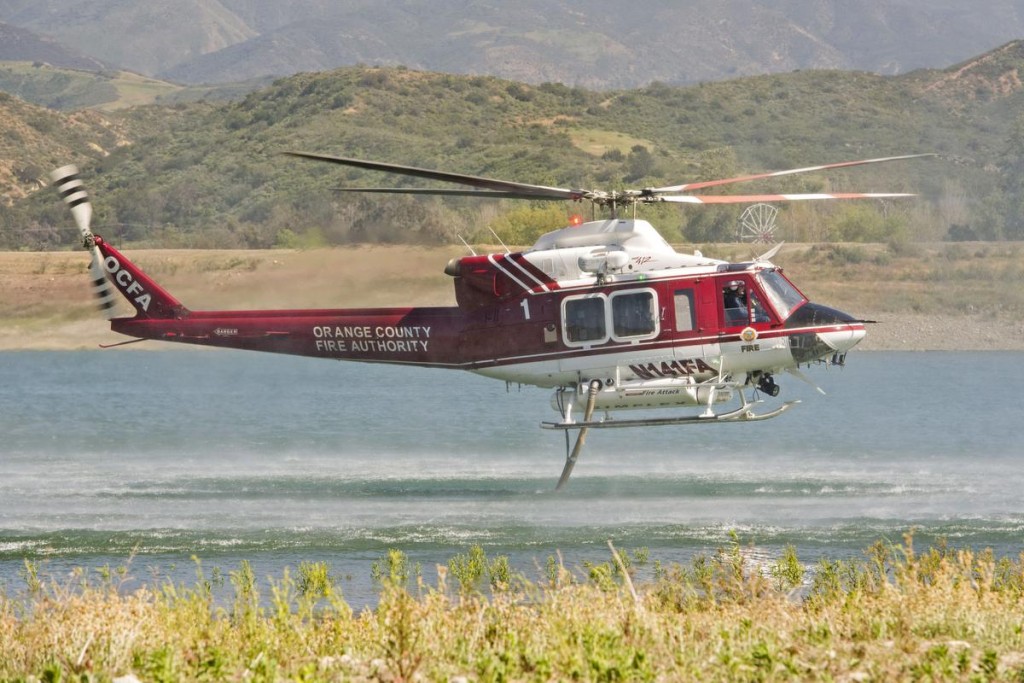
If the Orange County Fire Authority gets a call for air assistance, its helicopter crews are up in the air within minutes.
Already suited up, a pilot and crew chief – a paramedic is added on weekends – switch on a fully fueled Huey helicopter and begin climbing the sky to drop water on a fire or airlift a stranded hiker or injured bicyclist.
Until last month, most of this would have occurred only during daylight hours.
“If a fire started in Orange County at 11 o’clock at night, we wouldn’t be here. … All the crews would be home with their families in bed,” said Fire Capt. David Lopez, who is a crew chief on the helicopters. “If the fire was significant enough, they would call us. By the time we got back, the fire’s built up, and it would be harder to attack.”
However, the agency’s air operations center at the Fullerton Municipal Airport began a six-month pilot program March 20 in which its four birds rotate 24-hour shifts to cover day and night calls.
The move comes six years after an independent auditor recommended the fire authority could improve after the 2007 Santiago Fire that scorched more than 28,000 acres and destroyed 14 homes in Orange County.
Under the new program, one aircraft will be staffed with a pilot and crew chief, with a firefighter/paramedic rescuer added on the weekends, at an annual cost of $1.5 million. OCFA has also received military-grade night-vision goggles and training for its pilots to fly helicopters on night missions.
Other pilots and crew members can be recalled to work if more assistance is needed.
“On days when there’s extreme fire danger, we can go as deep as three aircraft in the air,” Lopez said.
When a rescuer is needed in the air during the week, they are picked up from one of four fire stations throughout the county.
The program is expected to save $6,000 because only one helicopter crew is working instead of two.
Previously, two helicopter crews worked a staggered 12-hour shift up to 8 p.m. during the week, and one crew worked a 10-hour shift on weekends, running the risk of small fires at night growing into larger ones, and injured or stranded hikers or bicyclists in sparsely populated areas facing longer wait times for help.
Because of budgetary and safety concerns, round-the-clock air operations took a back seat to other issues in the six years since adopting night-vision technology, said Gene Hernandez, vice chairman of the Fire Authority’s board of directors.
“There was significant changes occurring in the organization that we needed to address, and this wasn’t a front-burner issue,” Hernandez said, citing budget cuts at the time.
The extra coverage allows the fire agency to respond to the 25 percent of calls for air assistance that used to fall outside the previous 12-hour duty day, according to a staff report. Last year, the agency’s helicopters responded to 196 calls total.
The helicopters sometimes still flew at night, but only when on-call crews responded back to work.
The benefit of night flights was shown on Sept. 4, 2010, when the fire authority sent a helicopter into a nighttime blaze for the first time. The crew made 12 water drops, and helped contain a 10-acre fire in less than three hours. The flight crew was in the parking lot on its way home when they got the a call around 7:56 p.m. for assistance.
Yorba Linda resident Margot Boyer, who lives near Chino Hills State Park, said she was surprised to learn after the Santiago Fire about the lack of nighttime staffing. She began circulating a petition asking for better coverage.
“Is a fire just going to happen in those (daytime) hours?” she said. “Now I have some peace of mind.”
In Brea, some residents are still reeling from the 2008 Freeway Complex Fire that destroyed 187 homes, some near Carbon Canyon Road in Olinda Ranch.
“Because it’s such a team effort from all the resources in the area, it’s good to have one more helicopter,” Olinda Ranch resident Eric Johnson said.
The OCFA board will review the program in six months, where a decision will be made about its future.
“I feel confident that it will be successful,” Hernandez said.
Source: Orange County Register (Louis Casiano Jr, Staff Writer)